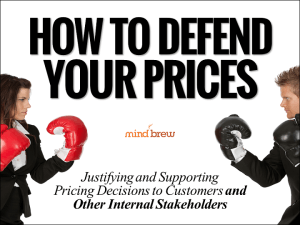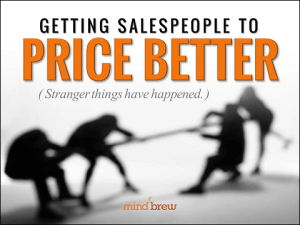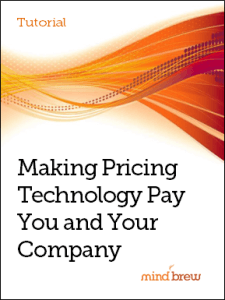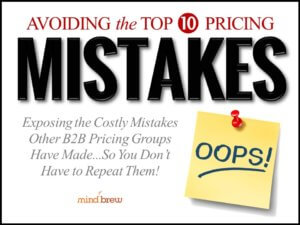Here’s a pseudo-philosophical question for you…
What’s the most expensive emotion? If you had to put a number on it, which emotion costs us humans the most, in terms of both direct expense and opportunity costs?
All things considered, I will submit that the most expensive emotion in the world…by far…is fear.
Think about how much money we all spend…individually and as a society…to assuage our fears in the present and mitigate our fears about the future. And too, consider how much opportunity we all forego because we’re simply too afraid to take action or incur risk.
In the pricing arena, fear is everywhere…and it’s costing us a fortune!
Why are our salespeople so quick to offer price concessions? They certainly have explanations and justifications that seem somewhat rational and logical in the moment. But the underlying emotion driving the production of these seemingly logical explanations is very often fear—fear of losing the deal, fear of angering the customer, fear of losing the commission, and so on.
And salespeople aren’t the only ones who experience this costly emotion.
As pricing people, we immediately second-guess the data-driven bids and quotes we put together, fearing the pushback we imagine we’ll get from the account team. We do a bunch of research to produce a value-based price only to reduce it by some arbitrary measure, fearing the customer reaction we’ve conjured in our imagination. We know this recent cost increase is a perfect opportunity to go for more and correct some historical pricing deficiencies, but we hold back out of fear of what “could” or “might” happen should we even try.
The emotion…the fear…actually comes first. The rationalizations that follow are very often just the logical “ointment” we create to soothe the emotion.
It’s not easy, but there are steps we can take to reduce the fear and uncertainty that leads to sub-optimal pricing decisions. Here are a few:
- Learn to recognize the fear. Once you acknowledge the role it might be playing, you can begin to recognize when fear is creeping into your own decision-making as well as the decisions of others.
- Stop trying to read minds. Sorry, but most of us are not psychic. So, stop trying to “anticipate” what others’ are thinking or how they will respond. Let them actually weigh-in before making adjustments or concessions.
- Get trained in negotiation. Trained negotiators will employ dozens of strategies and tactics to play on our fears in the interest of securing concessions. But when you and your salespeople have also been trained in negotiation, those strategies and tactics tend lose most of their power.
- Stop thinking “worst case”. The worst case scenario is so rare that there’s no point even thinking about it. Instead, think in terms of the “most likely” scenario. Worst case, the customer will get furious, stop returning calls, and shift all their business to a competitor. Most likely, however, the customer will just shake their head and say that we need to do better. And even that response might just be a negotiation tactic.
- Measure price elasticities. When you know…to a degree of mathematical certainty…how various segments respond to different price levels, you remove a tremendous amount of risk from the pricing process. Using elasticity measures, you don’t have to guess—you can accurately predict what will happen at any given price-point.
To be clear, fear is not a bad emotion. After all, fear is what protects us and keeps us out of harm’s way. In fact, without a healthy amount of fear, the human race would not have survived as long as we have.
That said, fear is not the most accurate of emotions. From a survival standpoint, it’s better to be safe than sorry, so our fear response tends to be calibrated on the “highly sensitive” side. It’s better to run away right now and wait until later to figure out whether there really was a tiger creeping up on us, right?
But in a business context, there are no tigers. So we have to try to recognize and control our natural fear responses. And when we take proactive steps to alleviate the underlying fear and uncertainty, it’s amazing how many of the excuses and rationalizations for sub-optimal pricing will simply evaporate.
















